How to Build Your Own Learning Management System From Scratch
18 min read
Page Content
- 1. Trends in Learning Management Systems Industry
- 2. Existing LMS Types
- 3. Examples of Ready-made LMS Solutions
- 4. Benefits of Custom Learning Management System
- 5. Challenges That You Will Face
- 6. Learning Management System Key Features
- 7. LMS Advanced Features
- 8. How to Create Your Own LMS from Scratch?
- 9. LMS Development Cost
- 10. How Can We Guide You Through Creating Your Own LMS Without Any Problems?
- 11. Conclusion
The pandemic forced many schools and organizations to adjust to the work-from-home model requested by the government. This is where the learning management system comes into play. LMS is software for quality content delivery, and it works by providing a platform for consistent, uninterrupted, and organized interactions between teachers and students. Companies also use this platform to manage the activities of their workers to improve productivity.
The Targeted audience for LMS includes students, sole-proprietors, business people, small and large scale companies. All these factors are crucial criteria when deciding to create LMS from scratch. The LMS platform consists of two significant parts: the student interface and the instructor’s interface. These two components are essential when creating your own learning management system.
Monetization of the LMS can be done through donations, paid subscriptions, certificates, in-app purchases, corporate learning offers, and premium benefits. An LMS works by using a website where only people with specific login and passwords can access. Lessons can be provided remotely or in person. LMS works by giving the information storage and organization location to support the learning system. Computers and various mobile devices are compatible and used by LMS users.
Trends in Learning Management Systems Industry
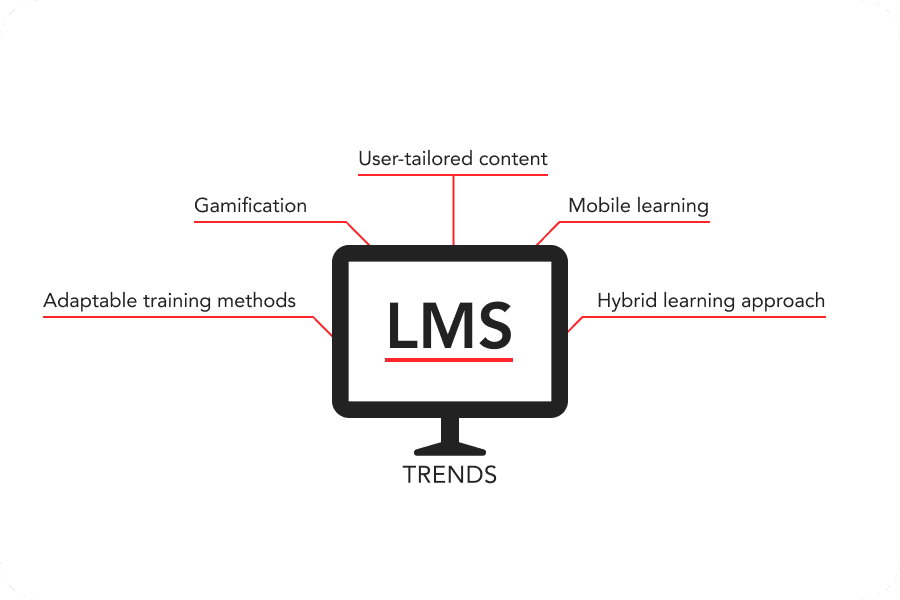
The Post-pandemic era has compelled many enterprises, students, and top experts to adjust to the emerging technological learning trends due to the impact of COVID. Speaking more than two languages is the latest obstacle businessmen, employees and high-ranking professionals need to overcome to meet current demands. Every company needs to learn How to Build an e-Learning Platform. The trends to consider when building your own learning management system includes:
- Hybrid learning approach: There are different methods of delivering online learning or skills assessments for language learners. The standard system includes virtual, augmented, and mixed reality techniques. Virtual reality involves programs that depict real-life scenarios in a computerized environment. Augmented reality is a programming technique that offers features that provide digitally enhanced real-world situations. Some organizations prefer to integrate digitalized and traditional learning methods called hybrid reality. This method helps to maximize different types of API in the long run. Using the mixed mode of delivery information is beneficial if you wonder how to create a learning management system that generates high market value and profit. It helps all categories of individuals, including those with reading difficulties.
- Adaptable training methods: Instructors need to adapt to teaching their students, employees remotely without compromising the quality of the training provided. Flexible teaching approaches are crucial when developing an LMS for websites or enterprises.
- User-tailored content: One of the latest trends in the e-learning niche is user-created content. Many companies prefer self-generated content to outsource from other parties. User-generated content (UGC) should be included in your itinerary if you are developing an LMS for your startup company. Previous traditional training programs are compliance-focused, while recent course outlines add leadership and communicative skills to the list of things their users need to master. Recent research shows that approximately 35% of the working population in 2020 were student employees. Build content that works for all categories of your targeted audience. That’s why it is more lucrative to create your own LMS app.
- Mobile learning: A good e-learning course would contain educational materials that can work on Android and iOS. We live in a technological era where most users access learning programs through their various mobile devices. Mobile Compliance is a top priority when deciding to develop your own LMS for mobile devices and online learning.
- Gamification: Boredom is a primary challenge of most e-learning products and services due to the prolonged repetition of the same course outline and materials. Gamification can solve this dilemma by providing fun and learning through different games. Gamification should become one of the core features if you plan to make an LMS design that offers the best community experience for its users.
The virtual learning trends above should be prioritized to create a top-notch learning management system.
Get free digital consultation from our well-trained experts!
Let’s conduct a call to advise you on when and how to create your LMS. Our experts would provide all the vital information needed for your LMS.
Contact usExisting LMS Types
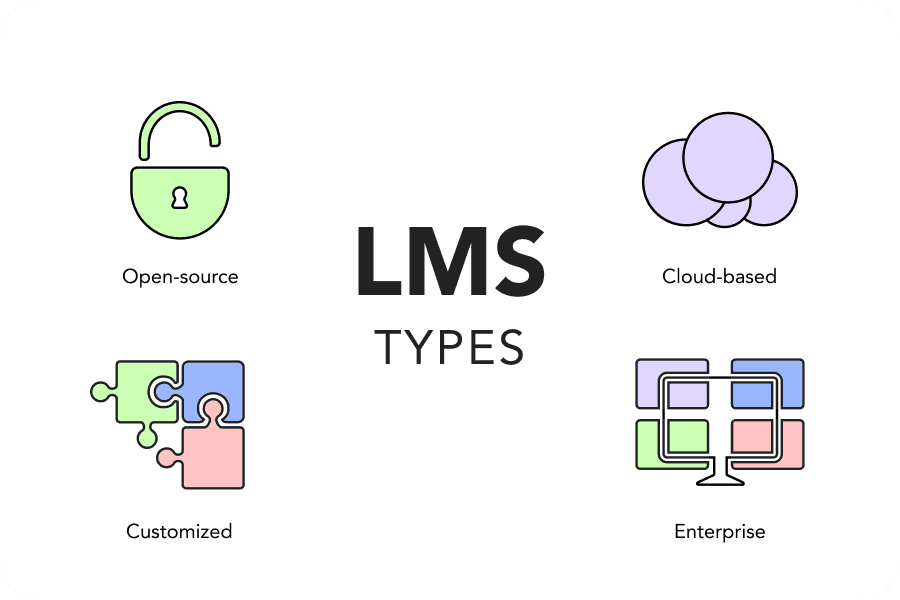
Proper selection is essential when you develop a learning management system that ticks all the boxes for the requirement specifications for your targeted audience and goals. The significant factors that influence the type of LMS to implement for your organization or school include:
- The type of vendor.
- The objectives of the students or employees.
- The priority level of add-ons.
- The number of prospective learners.
- Core and mandatory features are needed in the LMS.
The language management system can be classified into different categories. The types include:
LMS based on the kind of services provided
LMS can be grouped into different categories based on the type of service offered. The classifications include:
- Conventional LMS: This type of learning management system is not tailored to a specific targeted audience and can meet the needs of classrooms, employees, and corporate organizations.
- Modern LMS: This variant is learner-focused. It makes its participants more active and involved through different features such as gamification and mobile-friendly materials.
- Unified (Ecosystem) LMS: Most businesses are beginning to invest in management systems with centralized content. It’s easier for the learners to have access to the information, thereby enhancing the productivity of the learning process. This should be a priority when planning to build your own LMS project.
- Customized systems: Recent research shows that top-rated schools such as Harvard school of business are beginning to provide a custom-made learning platform tailored to provide specific skills to its users.
Classification Based on Type of Vendor
LMS can be divided into two different categories depending on the vendor type. The categories:
- Cloud/SaaS System: The owner and learners of this platform can access the stored information via the internet. Top executives of businesses and online private institutions are the common patronizers of this platform. This method of information dissemination can be used to enhance corporate learning among employees of a company.
- Hosted Type of LMS: Unlike the SaaS system, the information is stored in the owner’s host and only accessible to those permitted by the caretaker of the learning management system. Secured confidential information is a priority to most enterprises. This is why they invest in Hosted LMS. It is more protected than using a third-party platform.
Choose a vendor type that suits your goal and targeted audience.
LMS Type Based on Targeted Audience
The type of targeted audience can also be used to group LMS into two different categories, namely:
- LMS for Educational Purpose: Most top universities use this to keep their students up-to-date with their course outline, especially during distant learning. Online platforms such as Google Classroom were the previous learning solution for remote learning. However, this platform is becoming too crowded due to the pandemic, and most schools are already planning to build an LMS from scratch to cope with this rising demand.
- LMS for Corporate Organizations: Onboarding, staff training, and evaluation have been made easy through the corporate LMS. Companies can put all the information about their prospective and current employees in our location for quick access and assimilation.
LMS Classification Based on Payment
Learning management systems can also be classified based on their pricing plan into two different types :
- Free LMS: It is free of charge, flexible, and open source. Enterprises prefer this type of LMS because of the developer’s availability for feedback and support throughout the usage of the LMS website. Common examples of free LMS are CANVAS and Schoology.
- Paid LMS: E-learning management systems can also be commercial or run on users’ paid subscriptions. Organizations can use this type of LMS due to its numerous unique and custom features. Docebo is one of the trendings paid LMS in the educational niche.
Making an informed decision is crucial when deciding on how to create an LMS that helps you monitor the achievement and skills of your employees or students.
Do you need expert advice?
Just let us know - our team will perform an analysis and preliminary assessment, taking into account all the features of your project.
Contact usExamples of Ready-made LMS Solutions
There are many examples of ready-made LMS. The most common ones are:
- Learn upon;
- SAP Litmos;
- Talent LMS;
- Adobe Captivate Prime;
- Docebo.
The table below shows the similarities and differences between these types of LMS.
| Docebo | Adobe Captivate Prime | Talent LMS | SAP Litmos | Learn Upon | |
|---|---|---|---|---|---|
| Platform Beneficiaries | Learner and instructor. | Teachers and students. | Educators and learners. | Instructors and students. | Teachers and students. |
| Unique Features | Distance training possibility and user UI control. |
Remote features tailored for social learning. |
Availability of offline learning materials. |
Direct access to library and possibility of cross-team cooperation, Direct integration with report sheet. |
Protection of data, Prompt information upload through an in-app builder. |
| Targeted Audience | Audiences can be both internal and external. |
External and internal audiences, especially the finance, e-commerce, and retailing sector. |
Internal and external audience. | Internal and external audience. | Fortune Organizations. |
| Compatibility | Mac, Linux, Windows, Android, iOS. |
Mac, Linux, Windows, Android, iOS. |
Mac, Linux, Windows, Android, iOS. |
Mac, Linux, Windows, Android, iOS. |
Mac, Linux, Windows, Android, iOS. |
| Integration | Slack, Zoom, CRMs. | Slack, Zoom, CRMs. | asZendesk, Slack, Zoom, CRMs. | Slack, Zoom, CRMs. | Slack, Zoom, CRMs. |
| Pricing | The basic price is 1600 USD. | 4 USD monthly for learners. | 0-259 USD monthly, depending on the plan. |
4 USD monthly. | The price depends on the subscription type. It ranges from 699 USD- to 1999 USD. |
The type of LMS solution selected for your project could have a lasting impact on the company’s process, goal, and plans on how to develop an LMS for your business.
Get a Free Consultation!
Contact us to get all the information you need to start a ready-made LMS from pro experts.
Contact usBenefits of Custom Learning Management System

Financial Benefits
According to research, as of 2019, the LMS market is worth about 8.76 billion USD but is expected to increase by five folds by 2027, accounting for approximately 38.10 billion USD. The lucrative part of the business is why most companies want to create LMS from scratch for their site, school, or organization. It is a widely accepted method globally, especially in Asia. It is discovered that Asians are the most open to working with an E-learningApp Development Company (only second to Europeans) because between 2019 and 2027, the compound annual growth rate in Asia regions has increased by 19.75%. Recent research shows that approximately 30% of large organizations use the LMS platform to train and improve the workforce’s effectiveness.
There are many pros and cons of using custom LMS. The essential advantages are:
Flexible Control
One of the main benefits of customization is total control over the platform’s features, development, content, and appearance. Updates are very rapid since they are customized. The owner decides everything about the platform. This is an essential criterion when deciding how to create an LMS website.
Enhanced Security
All users want to use a platform where their confidential information is well secured. Custom LMS offers advanced security features such as biometric and two-step authentication. As the owner, you can quickly discover and prevent any security breach on your platform.
Tested Reliability
Having a customized LMS allows you to build a super-reliable platform. The developers would have well tested the management system for compliance and quality of the requested features for the platform.
Increased Valuation
Personalizing your platform increases the market value of your product. The increased valuation helps you increase the price and profit margin of the business.
Compatibility
It is easier for customized LMS to integrate with other third-party applications such as CRMs, Slack, Zoom, etc., compared to ready-made SaaS.
Challenges That You Will Face
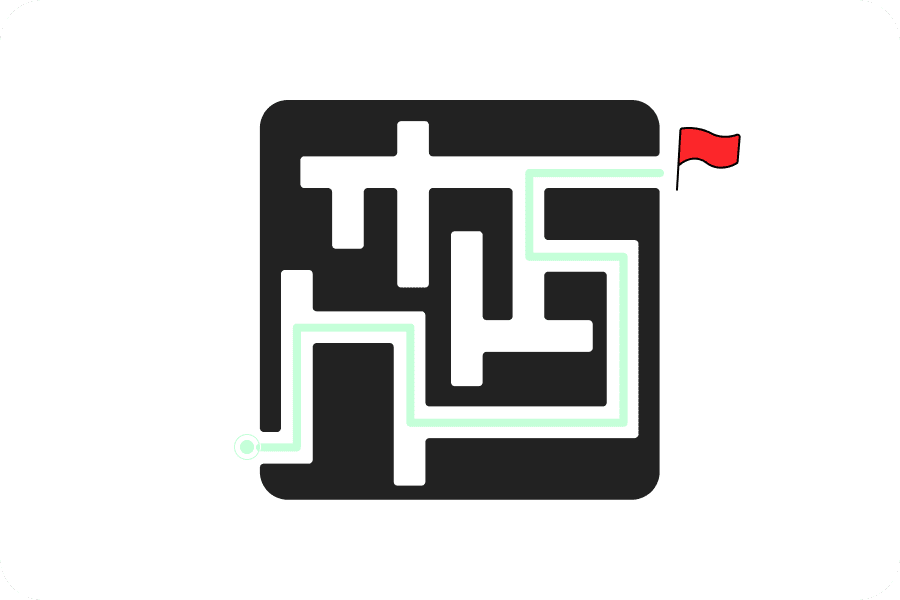
Security issues
One of the most crucial things about how to create an LMS website is keeping the content unique and protecting the user’s personal information. These problems can be solved by using enhanced encryptions, watermarking, SSL certificates, and double-layer authentication.
Poor Methodology Selection
It is advisable to use Agile and Scrum as your selected approach for creating your LMS. A good analysis program allows you to break your cycle into simple tasks with enough time for debugging. The website implementation is divided into sprints. Debugging is done after each one to ensure efficient progress tracking by the client. All necessary changes can be made promptly since the processes are done in milestones. CI/CD is an efficient technological method to ensure constant communication between the developing team and platform owners. This method helps to solve problems such as missing deadlines or human mistakes.
Lack of Expertise
If you want to successfully create an LMS website for your product, you would need the help of a team of well-trained experts. The professionals can help from the MVP production stage to the final release on the international stage.
Competitor Underestimation
Analyzing the Competitors can help you improve the efficiency of your product. This can be performed through market and competitor analysis. The product owner can do analysis using services such as Google analytics, or he can get pro analysis from discovery experts.
Learning Management System Key Features
Below are some crucial features you should prioritize when deciding how to build a learning management system.
User panel
It is mandatory to provide easy accessibility and authorization. This helps to speed up the learning process and improves the user experience. Also, A good LMS should provide students with such tools as progress tracking, reward system, reminders, in-app purchase discounts, skill assessment, certificate of participation, e.t.c.
The learners should select a tutor and customize their learning schedule.
Proper Assessment Tools
Consistent Skills assessment is a way to know if the students are improving or closer to their learning goal. An effective LMS provides tools that constantly check the progress and level of its users.
Admin panel
The dashboard for the admin needs to be flexible, easy to use, and well-arranged. It should be structured to easily manage accounts, create courses and customized content, track marketing tools and in-app purchases. It is more efficient when it grants the Admin Complete control over the platform by controlling the authorization of the authors and users.
Advanced searching tools
Finding suitable study materials is crucial for a good LMS. This can be achieved by Providing pop-ups assistance based on a recent search by learners and creating filter systems, where learners can search for information based on preferences.
Effective Feedback System
The constant evaluation, ratings, and testimonials of the users can increase referrals and the number of participants in the LMS. The best way to maximize this feature is to create a flexible grading system and skill assessment criteria for the course program.
Need efficient LMS features?
Let our professionals guide you in selecting the best LMS features for your program.
Contact usLMS Advanced Features
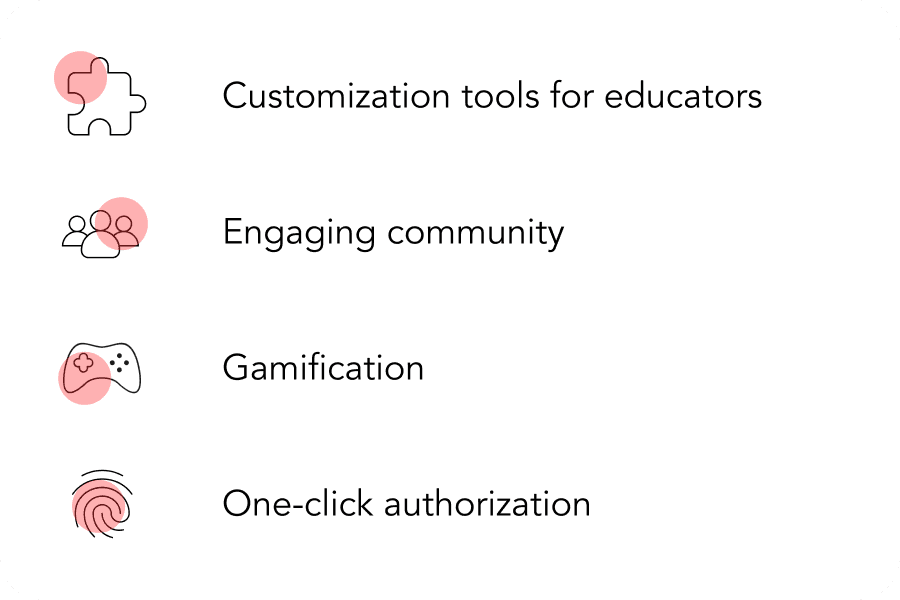
One-click authorization
Providing a learning platform that integrates perfectly with social media accounts is a plus for language learners. It makes authentication easy and faster, especially if the auto-complete feature is available.
Engaging community
The benefits of social learning can be maximized when an engaging community can interact with its tutor. This improves the tutor-learner relationship and the credibility of the program. More people trust the management system since the feedback from the students is heard and implemented.
Customization tools for educators
Granting content authors the privilege to customize the course program can make the learning more accessible. Additional plugins that allow the instructor to access translation, subtitles, and teaching materials rapidly could provide a competitive advantage and increase platform engagement for the program.
Gamification
Adding gaming features to your management system could be pivotal to keeping the user, regardless of their age group. It can motivate or help adults to relax while still learning. Quizzes, in-app games can enhance user engagement on your learning platform.
All these advanced features are needed when planning how to build a learning management system.
How to Create Your Own LMS from Scratch?
Planning and idea evaluation
During this stage, you can estimate the budget, audience, or obstacles to overcome during the production process. It is also essential to decide on compulsory features you want in the learning management system.
Selecting vendor type
Ensure the team and vendor you are working with have the right expertise for the job. It is essential to ask about their previous experience in creating similar programs.
Also, it will be better for you to study their portfolio, get acquainted with the reviews of other clients on independent services such as Сlutch.
Design creation
The prototype would preview the application’s principle, layout, look, and mode of operation. This stage benefits the owner, development team, and future investors. The investors would be more encouraged to patronize a software they have witnessed practically, not just theoretically.
Development and testing stage
The technology and methodological approach needed for the app should be decided earlier and updated when required. Scrum and Agile are some of the most effective development approaches for an LMS. The content management system should be subjected to continuous debugging and testing procedures during the development stage and after production.
Content/course creation
The content needs to be easy to change and assess by the authors and beneficial to the learners. Course outlines should be adaptable to the proficient level and students’ needs. The participants should have access to different contents, which vary based on difficulty. The course outlines can be drafted by third-party instructors or through established guidelines for teachers. There should be an anti-theft and plagiarism policy that helps protect the platform’s information. You can increase the integrity of the LMS by partnering with trusted scientific organizations or schools.
Post-production support
Signing a Post-release support contract with your vendor is crucial. You can request a maintenance training program for your staff.
The tips listed above are critical if you wonder how to make a learning management system from scratch.
You can find more info about LMS implementation steps in a separate blog.
LMS Development Cost
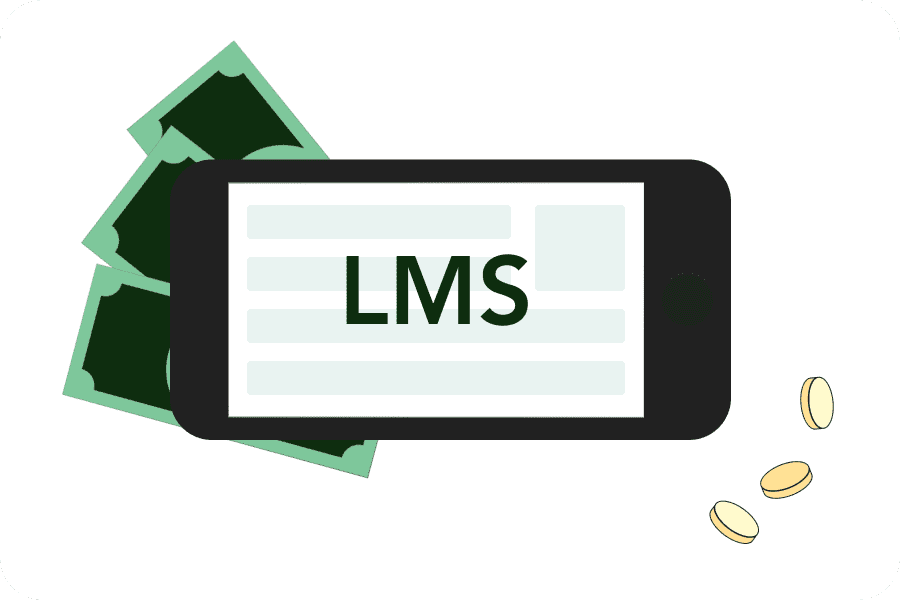
It is difficult to determine the final price for developing an LMS because it depends on factors such as the tech stack, features, and freelance or outsourcing company hired.
Generally, it takes Approximately 400-500 hours to build the prototype for your learning management system. The developers’ hour rate varies, depending on their expertise and location. American developers charge about 80-300 USD hourly for their services, compared to Ukrainian developers that cost an average of 35-56 USD hourly.
The price doesn’t necessarily determine the quality of the job. Despite their affordable hourly rate, Ukrainian engineers are well known for their top-notch service. Our experience and statistics of the last two years show that the estimated budget for developing an LMS can be calculated taking into account the following factors:
- Set-up Price: This costs an average of 4000-25000 USD.
- Fee for License: This costs approximately 20000 USD per year or 2-5 USD per user.
- Promotion costs: Marketing is critical to a learning application and can cost approximately 10,000 USD. Of course, this price can be even higher - depending on the application scale, the target audience, and your budget. Codempire uses cheaper but effective variants which include early adopters, influencers, and viral marketing. This option allows you to test and improve the features of the application.
- Hidden Cost: There could be a lot of miscellaneous expenses such as once and for all payment of 25000 USD for self-hosted platforms, Add-on fees of 99-1199 USD every month. Frequently hidden charges can be incurred during the development process due to poor planning and estimation. The best way to avoid these hidden costs is to work with a budget and developmental plan provided by an experienced team from the beginning to the end of the project. Sometimes the IT specialist charges 4000 USD per month. Remember, all these values are rough estimates and subject to change. You would be able to finalize a specific budget when you meet the developing team for your project. They would inform you about the budget and time cost for the app.
How Can We Guide You Through Creating Your Own LMS Without Any Problems?
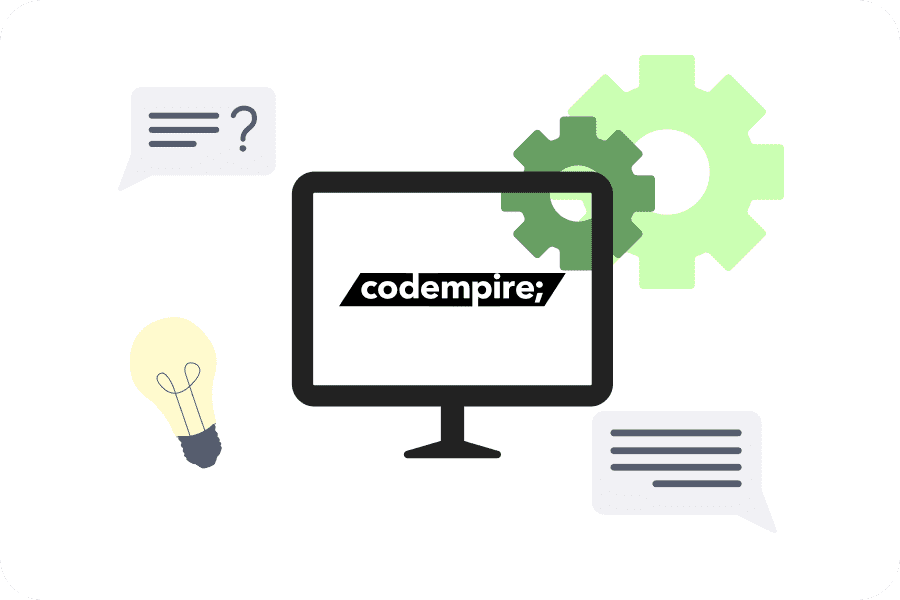
Codempire is a company that has vast experience in developing e-learning applications. We have a team of professionals that can help you build your LMS regardless of the type you want (ready-made or customized). Our services include programs with reward systems and advanced features.
Here you can see other advantages of hiring us:
Cloud-based LMS
We offer a cloud LMS system that can accommodate many users at once without any problem. It is well protected against fraud or internet assaults.
All-Inclusive application
Codempire has previous experience cresting LMS for different age groups, including children. We can add additional features such as calculation games or career ladder emulators. With us, all your target audience are covered.
Efficient visual solution
The motivation and understanding of learning benefits are lower in children than adults. This is why providing an extra incentive through visual aids can be an added benefit to your LMS. Our UI/UX specialists would add color, enthusiasm, and brightness to your application.
Professional Expertise
Codempire consists of a licensed team with vast experience working with international projects and developed countries like the US and Singapore. We can guide your startup company until it becomes the leading application globally. Our professionals use high-rated technology such as React Native to save you time and money through its hybrid development benefit.
Conclusion
- Creating an LMS from scratch could be challenging if you don’t know how it works and which company to hire despite its lucrative benefits.
- Implementing recent trends such as mobile learning, a mixed teaching approach, and flexible content are compulsory for an effective LMS.
- There are different pros and cons of most learning management systems. It is advisable to weigh all options and select what fits your business goals. Work with a team of experts before choosing a ready-made or customized LMS.
- Challenges such as poor competitor analysis or methodology could derail your plan for a top-notch learning management system. Identify these challenges early and provide efficient ways to tackle them.
- “By implementing features such as (User interface, Admin panel, Advance searching tools, One-click authorization, and gamification ) will help to increase user engagement, monetization, and popularity of your platform.
- The cost of developing an LMS from scratch is difficult to estimate. However, outsourcing a company like Codempire can guide you through the journey and provide you with services worth the payment. It costs around 36-52 USD per hour to hire a Ukrainian developer for your project.
#MVP
#e-learning